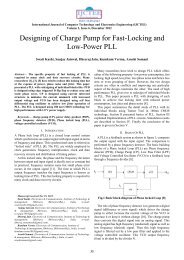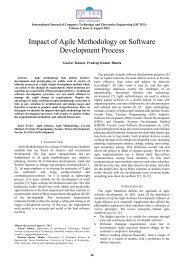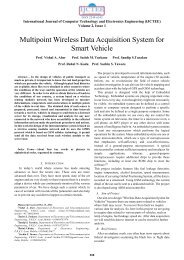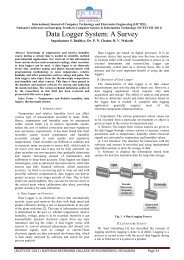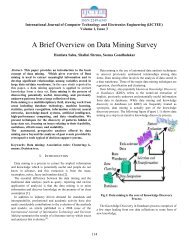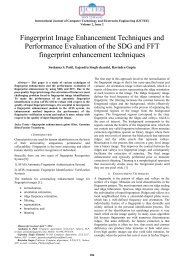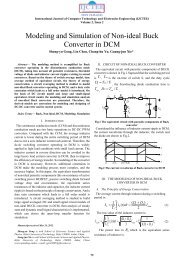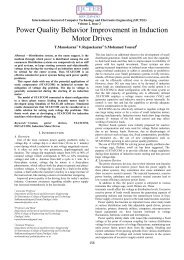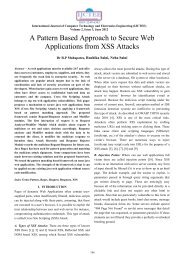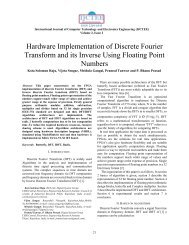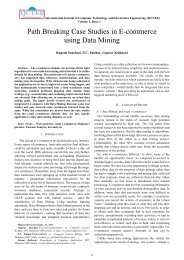Advantages and Disadvantages of Using a ... - ResearchGate
Advantages and Disadvantages of Using a ... - ResearchGate
Advantages and Disadvantages of Using a ... - ResearchGate
You also want an ePaper? Increase the reach of your titles
YUMPU automatically turns print PDFs into web optimized ePapers that Google loves.
ISSN 2249-6343<br />
International Journal <strong>of</strong> Computer Technology <strong>and</strong> Electronics Engineering (IJCTEE)<br />
Volume 2, Issue 6, December 2012<br />
<strong>Advantages</strong> <strong>and</strong> <strong>Disadvantages</strong> <strong>of</strong> <strong>Using</strong> a<br />
Blogging Activity in a College Euclidean<br />
Geometry Course<br />
Md. Mokter Hossain, Robert J. Quinn<br />
<br />
Abstract – This study explored student perceptions <strong>of</strong> a 12-<br />
week blogging activity that was a st<strong>and</strong>ard component <strong>of</strong> a<br />
college Euclidean Geometry class <strong>of</strong>fered in a university in the<br />
Western United States. This paper presents qualitative data<br />
regarding student perceptions <strong>of</strong> the advantages <strong>and</strong><br />
disadvantages <strong>of</strong> using blogs as supportive tool in the<br />
Euclidean Geometry course. Data were collected by asking two<br />
open-ended items <strong>and</strong> analyzed using MAXQDA, a Qualitative<br />
Data Analysis program. The study uncovered ten themes<br />
related to advantages <strong>and</strong> six themes related to disadvantages<br />
<strong>of</strong> using the blogging activity as a supportive tool for teaching<br />
<strong>and</strong> learning in this class. Each <strong>of</strong> these themes was labeled by<br />
an in vivo code. The themes were not independent <strong>of</strong> one<br />
another, but instead showed interconnected aspects <strong>of</strong> an<br />
overall phenomenon.<br />
Index Terms— Blog, Euclidean Geometry, Mathematics<br />
Education, Preservice Teachers, Online Discussion Board<br />
I. INTRODUCTION<br />
Technology has been included as an important principle<br />
in the National Council <strong>of</strong> Teachers <strong>of</strong> Mathematics’<br />
(NCTM) Principles <strong>and</strong> St<strong>and</strong>ards for School Mathematics<br />
(NCTM, 2000) in the United States. The technology<br />
principle states that technology is a tool that can enhance the<br />
teaching <strong>and</strong> learning <strong>of</strong> mathematics. According to<br />
Principles <strong>and</strong> St<strong>and</strong>ards, with appropriate use <strong>of</strong><br />
technology students can better underst<strong>and</strong> the underlying<br />
meaning <strong>of</strong> mathematics <strong>and</strong> learn mathematics more easily.<br />
Technology can enrich students’ range <strong>and</strong> the quality <strong>of</strong><br />
their mathematical inquiry by providing a means <strong>of</strong> viewing<br />
mathematical ideas from multiple perspectives (NCTM,<br />
2000).<br />
The NCTM [1] Principles <strong>and</strong> St<strong>and</strong>ards recommends<br />
that students use technology as an aid to help solve<br />
mathematical problems <strong>and</strong> enhance learning skills. They do<br />
not suggest, however, that technology should replace the<br />
role <strong>of</strong> the mathematics teacher. Instead, they envision that<br />
students in a mathematics classroom should have access to<br />
technology to facilitate their mathematics learning under the<br />
guidance <strong>of</strong> a skillful teacher who will decide when <strong>and</strong> how<br />
technology will be used. Further, they expect that teachers<br />
will play multiple roles in a technology-rich classroom to<br />
facilitate students’ learning in appropriate ways (pp. 25-26).<br />
Thus, information technology should play an<br />
increasingly important role in the teaching <strong>and</strong> learning <strong>of</strong><br />
mathematics at all levels. Currently, most mathematics<br />
classrooms in the United States have advanced technological<br />
tools including high-speed Internet connected computers,<br />
projectors, smart-boards, graphing calculators, <strong>and</strong> various<br />
st<strong>and</strong>alone mathematical s<strong>of</strong>tware packages such as:<br />
Geometer’s Sketchpad, Math Arena Advanced, <strong>and</strong> Data<br />
Explorer, as well as TI-84 Graphing Calculators <strong>and</strong><br />
Explorer Calculators [2, 3]. Unfortunately, however,<br />
information technology has not reached its full potential in<br />
mathematics education programs across the U.S. [4, 5].<br />
Many prospective mathematics teachers’ feel the current<br />
role <strong>of</strong> technology in mathematics education is not<br />
satisfactory [6]. Most preservice mathematics teachers<br />
identified technology as important in education; however,<br />
many <strong>of</strong> them felt that after graduation they might not be<br />
well prepared to teach using technology [4, 7, 8].<br />
Mathematics is a subject that requires considerable<br />
interaction between teacher <strong>and</strong> student when a student<br />
encounter difficulty; however, most mathematics learning<br />
s<strong>of</strong>tware does not provide an opportunity for students to ask<br />
questions when they face difficulty [9]. Moreover, most<br />
mathematics s<strong>of</strong>tware as well as traditional web-based<br />
programs are very costly <strong>and</strong> require frequent updates <strong>of</strong><br />
purchased licenses. Some require a yearly license fee <strong>and</strong> a<br />
high-speed Internet <strong>and</strong> computer system to run; thus, they<br />
are beyond the accessibility <strong>of</strong> students <strong>and</strong> teachers in<br />
many rural school districts [10]. As a result, a large portion<br />
<strong>of</strong> students, teachers, <strong>and</strong> classrooms across the world<br />
cannot afford <strong>and</strong> use purchased mathematics s<strong>of</strong>tware <strong>and</strong><br />
web-based applications.<br />
Fortunately, Web 2.0 technology, a new development <strong>of</strong><br />
the Internet services available on the World Wide Web,<br />
allows Internet users to collaborate <strong>and</strong> share web<br />
information actively (O'Reilly, 2005). Thus, Web 2.0 has<br />
great potential to create new opportunities <strong>and</strong> challenges,<br />
especially for mathematics teachers, <strong>and</strong> educators seeking<br />
to develop new models that will be available <strong>and</strong> affordable<br />
to almost all students, teachers, <strong>and</strong> mathematics classrooms<br />
in the world. The continuing spread <strong>of</strong> Web 2.0-based free<br />
applications could provide an alternative means <strong>of</strong><br />
supporting a large population <strong>of</strong> mathematics students,<br />
teachers, <strong>and</strong> classrooms who cannot afford to purchase<br />
licensed mathematics s<strong>of</strong>tware or flexible online teachinglearning<br />
systems.<br />
1
ISSN 2249-6343<br />
International Journal <strong>of</strong> Computer Technology <strong>and</strong> Electronics Engineering (IJCTEE)<br />
Volume 2, Issue 6, December 2012<br />
Web 2.0 may be an especially effective avenue for<br />
fostering mathematics learning in today’s technologically<br />
advanced young students, who tend to use the Internet<br />
through wireless means.<br />
A Blog is a st<strong>and</strong>ard example <strong>of</strong> Web 2.0 technologies<br />
[11] <strong>and</strong> is one <strong>of</strong> the easiest applications <strong>of</strong> Web 2.0<br />
technologies. Blogs <strong>of</strong>fer unlimited possibilities for building<br />
collaborative teaching-learning environments in<br />
mathematics education. Creating a blog is one <strong>of</strong> the fastest<br />
growing Web 2.0 activities among mobile Internet users<br />
[12]. Blogs promote reflective practice as well as<br />
collaboration <strong>and</strong> social interaction among users [13]. Blogs<br />
can be used as a means <strong>of</strong> obtaining or outsourcing solutions<br />
<strong>of</strong> quizzes, fallacies, <strong>and</strong> various mathematical problems<br />
students need to know to be prepared for competitive tests.<br />
Figure 1 shows a screenshot <strong>of</strong> the homepage <strong>of</strong> the<br />
blogging activity. The blogging activity was designed to run<br />
for twelve weeks <strong>and</strong> was a regular component <strong>of</strong> this<br />
course. The students were divided into six groups with five<br />
students in five <strong>of</strong> the groups <strong>and</strong> three in the remaining<br />
group. Each week the researcher uploaded a new problem<br />
set. The six groups were r<strong>and</strong>omly assigned to a pair <strong>of</strong><br />
weeks, 1 st <strong>and</strong> 7 th , 2 nd <strong>and</strong> 8 th , 3 rd <strong>and</strong> 9 th , 4 th <strong>and</strong> 10 th , 5 th <strong>and</strong><br />
11 th , or 6 th <strong>and</strong> 12 th . During the weeks to which they were<br />
assigned, group members were responsible for solving<br />
problems <strong>and</strong> leading the discussion board activity on the<br />
blog. The schedule was purposely set so that each group was<br />
assigned one week during the first half <strong>of</strong> the activity <strong>and</strong><br />
another week in the second half. Each student created a<br />
pseudonym to maintain confidentiality throughout the<br />
activity.<br />
II. METHODOLOGY<br />
This study explored preservice mathematics teachers’<br />
perceptions <strong>of</strong> using a blogging activity as a supportive<br />
teaching-learning tool in a college Euclidean geometry<br />
course <strong>of</strong>fered in a university in the western United States.<br />
The blog can be visited at:<br />
http://edsc353fall2011.wordpress.com/. The study was<br />
conducted over 12 consecutive weeks during a semester in<br />
which the blog was a st<strong>and</strong>ard component <strong>of</strong> a college<br />
Euclidean Geometry class.<br />
This paper describes the qualitative data that were<br />
collected in response to two separate open-ended items:<br />
(i) What were the advantages <strong>of</strong> this blogging activity?<br />
(ii) What were the disadvantages <strong>of</strong> this blogging activity?<br />
These questions were asked to answer the research question:<br />
What do preservice secondary mathematics teachers<br />
perceive as the advantages <strong>and</strong> disadvantages <strong>of</strong> using a<br />
blog as a supportive tool in a Euclidean Geometry course?<br />
All <strong>of</strong> the respondents typed their response to each question,<br />
based on their practical experience in participating in the<br />
blogging activity over a period <strong>of</strong> 12 weeks. The qualitative<br />
data described <strong>and</strong> presented in this paper were collected<br />
through a survey developed by the researchers (Appendix-<br />
A) <strong>and</strong> from the students’ postings to the online discussion<br />
board on the blog.<br />
There were 29 students enrolled in the class <strong>and</strong> all <strong>of</strong><br />
them agreed to participate in the blogging activity. One<br />
student, who attended only two class sessions <strong>and</strong> did not<br />
continue the course, did not participate in this study. Finally,<br />
all 28 remaining students continued in the blogging activity<br />
<strong>and</strong> participated in the study. It is noted that the students<br />
were given a choice to join or not to join in the blogging<br />
activity; with an alternate assignment provided by the<br />
instructor to those students who did not wish to participate<br />
in the blogging activity. However, nobody refused to attend<br />
in the blogging activity. All <strong>of</strong> the students enrolled in this<br />
course <strong>and</strong> a preservice teacher auditing the course as part <strong>of</strong><br />
an independent study were asked to participate. Most <strong>of</strong> the<br />
students in this course were secondary mathematics<br />
education majors; however, a few were majoring in other<br />
areas.<br />
Figure 1. A Screenshot <strong>of</strong> the Homepage <strong>of</strong> the Blog used for this<br />
Study<br />
Each group member was responsible for submitting a<br />
complete solution, to one <strong>of</strong> the eight problems posted<br />
during the weeks assigned to their group. Additionally,<br />
during the assigned week, at least one group member was<br />
responsible for initiating a new discussion thread <strong>and</strong> the<br />
other group members were expected to contribute to the<br />
thread.<br />
Additionally, throughout the semester each class<br />
member was required to post at least five substantive<br />
comments to solutions posted by other students; <strong>and</strong> to<br />
actively participate in the online discussion. Substantive<br />
comments included verifying a solution posted by someone<br />
else, fixing an incorrect or partially incorrect solution, or<br />
providing an alternative solution. In the online discussion<br />
board, a student could raise a discussion topic such as a<br />
contemporary issue related to the topics taught in the class<br />
or comment on threads that had been started by other class<br />
members. The address <strong>of</strong> the online discussion board:<br />
http://edsc353fall2011.wordpress.com/discussion-board/<br />
2
ISSN 2249-6343<br />
International Journal <strong>of</strong> Computer Technology <strong>and</strong> Electronics Engineering (IJCTEE)<br />
Volume 2, Issue 6, December 2012<br />
During the 12-week activity, there were more than<br />
6,500 visits to the blog; <strong>and</strong> there were 174 responses with<br />
66 threads on the discussion board. Prior to collecting data,<br />
permission was sought from the Institutional Review Board<br />
(IRB) <strong>of</strong> the university where the study was conducted; <strong>and</strong><br />
participants’ consent was taken through an assent form,<br />
prescribed by the university. Additionally, an information<br />
script describing the purpose <strong>of</strong> the survey was read aloud to<br />
the students. The students were given a choice to participate<br />
or not participate in the study without any penalty or loss <strong>of</strong><br />
rights to which they were entitled in the class. All<br />
individuals who agreed to participate were given the survey<br />
to complete in the absence <strong>of</strong> the researcher. Thus, the<br />
researcher did not have control <strong>of</strong> participants’ feedback in<br />
this study. There were 29 students enrolled in the class; all<br />
28 students who attended class regularly, participated in the<br />
study.<br />
III. RESULTS<br />
The participants <strong>of</strong> the 12-week long blogging activities<br />
found a number <strong>of</strong> advantages <strong>and</strong> disadvantages <strong>of</strong> using<br />
blogs as a supportive tool in a Euclidean Geometry course.<br />
While coding this qualitative data, MAXQDA revealed ten<br />
themes related to advantages <strong>and</strong> six themes related to<br />
disadvantages <strong>of</strong> using the blogging activity as a supportive<br />
tool in a Euclidean Geometry course. Each <strong>of</strong> these themes<br />
was labeled by an in vivo code, an actual word or phrase<br />
used by one or more <strong>of</strong> the participants.<br />
This was done in order to preserve the actual language<br />
used by the participating preservice mathematics teachers in<br />
describing particular advantages or disadvantages <strong>of</strong> using<br />
the blogging activity as a supportive tool in this class. These<br />
themes were not independent <strong>of</strong> one another, but instead<br />
show interconnected aspects <strong>of</strong> an overall phenomenon.<br />
Figure 2. Major <strong>Advantages</strong> <strong>of</strong> the Blogging Activity<br />
3
ISSN 2249-6343<br />
International Journal <strong>of</strong> Computer Technology <strong>and</strong> Electronics Engineering (IJCTEE)<br />
Volume 2, Issue 6, December 2012<br />
ADVANTAGES OF THE BLOGGING ACTIVITY<br />
Table 1 depicts the themes <strong>and</strong> subthemes related to the<br />
major advantages <strong>of</strong> the blogging activity in the Euclidean<br />
Geometry class, taken from the survey data. The table also<br />
delineates the subthemes that emerged. Figure 2 depicts the<br />
major advantages <strong>of</strong> the blogging activity drawn by the<br />
MAXMaps feature <strong>of</strong> MAXQDA. The following section<br />
describes the major advantages <strong>of</strong> using the blogging<br />
activity as a supportive tool in a Euclidean Geometry<br />
course.<br />
Table 1<br />
Themes <strong>and</strong> Subthemes Related to the Major<br />
<strong>Advantages</strong> <strong>of</strong> the Blogging Activity<br />
Themes<br />
Subthemes (in vivo codes)<br />
24/7 Accessible Anytime accessible, anywhere<br />
accessible<br />
Alternative Source Alternative solution, another<br />
resource, easier solution<br />
Collaborative Collaborative, interact, correct each<br />
other’s mistake<br />
Convenient<br />
Easy to use, effective, familiar,<br />
Enjoyable<br />
Enjoyed, excited, interest<br />
Encouraging Forced to think, showing to<br />
integrate technology<br />
Engaging<br />
It was engaging, exposed to<br />
analyze more<br />
Getting Feedback Feedback, positive critique<br />
Safe <strong>and</strong> Secured Anonymous, pseudonym, privacy,<br />
security<br />
Technology Savvy More technology savvy, it was<br />
technology savvy<br />
24/7 Accessible. Anytime <strong>and</strong> anywhere accessibility was<br />
one <strong>of</strong> the most common advantages <strong>of</strong> the blog that most <strong>of</strong><br />
the participants reported. They found the blog accessible<br />
through their computers, laptops, iPods, <strong>and</strong> iPhones on a<br />
24/7 basis. One participant mentioned: “One <strong>of</strong> the<br />
advantages [<strong>of</strong> the blog] was the ability to check what you<br />
need to do anytime anywhere.” Another participant<br />
elaborated on her similar experience: “I was able to work on<br />
it anytime throughout the week. It was different than other<br />
activities I have done in the past, which was cool. It is a<br />
more modern way to engage students.” Another participant<br />
mentioned: “Having the ability to discuss questions <strong>and</strong> post<br />
comments at any time throughout course was very<br />
beneficial.” Another participant noted: “You could post or<br />
reply as things occurred to you, at your own pace.” That was<br />
supported by other participants’ notes: “I can take as much<br />
time as I need”; “I could post comments / discussions at my<br />
leisure time”; <strong>and</strong> “I was able to do this on my own time.”<br />
Alternative Source. The participants found the blogging<br />
activity to be an alternative source <strong>of</strong> getting different or<br />
easier solutions to the problems they attempted to solve.<br />
One participant noted: “I think that the blogging activity<br />
helped students find different ways to solve problems.”<br />
Another participant reported: “This [blogging activity]<br />
<strong>of</strong>fered another resource to practice from.”<br />
Another participant mentioned: “If I didn’t know how to<br />
complete a problem, I could look at how other students<br />
answered it on the blog.” Another student noted: “It<br />
[blogging] was an interactive activity outside <strong>of</strong> class which<br />
allowed students to apply what they had learned <strong>and</strong> found<br />
errors or alternative solutions on others’ work.” Another<br />
participant described: “Another benefit was the different<br />
ways <strong>of</strong> solving problems which allowed me to find an<br />
easier solution. I also thought that the blog allowed me to<br />
get a better feel <strong>of</strong> the students in my class. Another benefit<br />
is if a tutor needed a reference to help a student in the class<br />
the tutor could refer to the blog to help.”<br />
Collaborative. The participants found the blogging activity<br />
to be a collaborative platform for effective communication<br />
with the instructor <strong>and</strong> other participants in the class. One<br />
participant commented: “It was a different way to<br />
incorporate collaboration <strong>of</strong> classmates. The feedback given<br />
from other students to my solutions was helpful to my future<br />
teaching techniques.” Another participant elaborated: “We<br />
were exposed to a variety <strong>of</strong> problems relating to Geometry.<br />
We were presented with alternative methods in solving, as<br />
well as different reasoning procedures. We were forced to<br />
think through our solving process <strong>and</strong> analyze <strong>and</strong> critique<br />
others.” Another participant noted: “The ability to interact<br />
with classmates <strong>and</strong> correct each other’s mistakes or<br />
comment on solutions was an advantage.”<br />
Convenient. The participants found the blog to be an easy<br />
<strong>and</strong> effective tool for learning <strong>and</strong> practicing Euclidean<br />
Geometry. One participant noted: “It was very accessible;<br />
<strong>and</strong> the means <strong>of</strong> blogging was very efficient.” Another<br />
participant narrated: “It [blogging] was an interactive<br />
activity outside <strong>of</strong> class which allowed students to apply<br />
what they had learned <strong>and</strong> found errors or alternative<br />
solutions on others’ work. It was easy, accessible, <strong>and</strong><br />
effective.” Another participant elaborated: “Students were<br />
used to the [blogging] technology <strong>and</strong> were excited when<br />
they incorporated something they were familiar <strong>and</strong> skilled<br />
with to something they were learning. This technology has<br />
so much potential <strong>and</strong> efficiency, if it utilized correctly, it<br />
can be such a useful tool.”<br />
Enjoyable. The participants found the blogging activity to be<br />
an enjoyable learning tool. One participant commented: “I<br />
enjoyed the connection to modern media. I think it was<br />
helped to hold student-centered discussion.” S/he also noted:<br />
“Students are used to this technology <strong>and</strong> are excited when<br />
they incorporate something they are familiar <strong>and</strong> skilled<br />
with to something they are learning. This technology has so<br />
much potential <strong>and</strong> efficiency, if it utilized correctly, it can<br />
be such a useful tool.” Another participant noted: “I think it<br />
would work to the interest <strong>of</strong> most students.”<br />
Encouraging. The participants found the blogging activity to<br />
be a means <strong>of</strong> encouraging themselves to be active<br />
participants. One participant commented: “We were forced<br />
[ourselves] to think through our solving process <strong>and</strong> analyze<br />
<strong>and</strong> critique others.”<br />
4
ISSN 2249-6343<br />
International Journal <strong>of</strong> Computer Technology <strong>and</strong> Electronics Engineering (IJCTEE)<br />
Volume 2, Issue 6, December 2012<br />
Another participant reported: “Showing us all as future<br />
educators another way to integrate technology into the<br />
classroom.” Another participant reported: “Getting a grade<br />
based on the future activity rather than just one problem<br />
enforced the advantage <strong>of</strong> learning from the activity.”<br />
Engaging. The participants found the blogging activity to be<br />
an engaging tool for learning Euclidean Geometry. One<br />
participant commented: “It provided more examples to<br />
problems, it was engaging, because it was online I liked that<br />
the activity was continuous all the way through the<br />
semester. It was not difficult to figure out.” Another<br />
participant elaborated: “This blogging activity was great for<br />
preparing for quizzes. The questions were very similar to<br />
those we did in class <strong>and</strong> saw on the quizzes. It also allowed<br />
me to talk what topics related to education, but not<br />
necessarily Geometry.” Another participant elaborated: “We<br />
were exposed to a variety <strong>of</strong> problems relating to Geometry.<br />
We were presented with alternative methods in solving, as<br />
well as different reasoning procedures.” Another comment<br />
was concise but very notable: “It made me analyze the<br />
chapter problems more.”<br />
Getting Feedback from Others. Getting feedback from<br />
fellow classmates’ comments <strong>and</strong> opinions on their work on<br />
the blog was impressive for the participants. One participant<br />
mentioned: “It’s very useful to have feedback from fellow<br />
classmates along with feedback from the teachers.” Another<br />
participant noted: “I think that the blogging activity … also<br />
helped students come up with ways to positively critique<br />
other student’s answer <strong>and</strong> thoughtfully reply to questions.”<br />
Another participant elaborated on his or her similar<br />
experience: “The main advantage was doing a problem <strong>and</strong><br />
getting feedback from classmates.”<br />
Table 2 depicts the themes related to the disadvantages/<br />
problems <strong>of</strong> the blogging activity in the Euclidean Geometry<br />
class, taken from the survey data. The table also delineates<br />
the subthemes that emerged within these themes.<br />
Table 2<br />
Themes <strong>and</strong> Subthemes Related to the Major<br />
<strong>Disadvantages</strong>/Problems <strong>of</strong> the Activity<br />
Themes<br />
Subthemes (in vivo codes)<br />
No Disadvantage None, no disadvantage, no problem<br />
Difficult for New Difficult to start, hard to follow, I<br />
Bloggers<br />
Difficult in Geometric<br />
Notations<br />
Enforcing<br />
Monotonous<br />
Personal Dislike<br />
was not sure<br />
Could not add a picture, could not<br />
draw a figure, could not use<br />
symbols, difficult to write<br />
equations<br />
Forced me to collaborate,<br />
personally got tired<br />
Boring, I did not get interest, no<br />
one there to help<br />
I did not like blogging, I do not<br />
like criticize others<br />
Safe <strong>and</strong> Secured. The impersonal nature <strong>of</strong> the blogging<br />
activity was considered to be a great advantage to many<br />
participants. Due to using pseudonyms instead <strong>of</strong> their<br />
actual names, the participants found the blog was as a safe<br />
<strong>and</strong> secured platform to express their opinion anonymously.<br />
One participant reported: “No one knew my pseudonym so<br />
if I got something wrong it wouldn’t directly link back to<br />
me.” Another participant stated it concisely: “Not shy about<br />
speaking out since pseudonyms.” Another participant noted:<br />
“It [blog] allowed for privacy <strong>and</strong> security for students.”<br />
Technology Savvy. The blogging activity not only required a<br />
certain level <strong>of</strong> technology savvy from participants, it also,<br />
served to improve the level <strong>of</strong> technology savvy <strong>of</strong> many <strong>of</strong><br />
them. One participant reported: “[With the blogging<br />
activity] I became more technology savvy.” Another<br />
participant commented: “[The blogging activity was]<br />
convenient, easy, [<strong>and</strong>] more technology savvy.”<br />
DISADVANTAGES/PROBLEMS<br />
Most <strong>of</strong> the participants did not find any disadvantage<br />
<strong>of</strong> the blogging activity as a supportive tool in a Euclidean<br />
Geometry course. However, some participants found <strong>and</strong><br />
reported some minor problems <strong>of</strong> using a blog as a<br />
supportive tool in a Euclidean Geometry course.<br />
Figure 3. Major <strong>Disadvantages</strong>/Problems Found in the<br />
Blogging Activity<br />
Figure 3 depicts the major disadvantages found in<br />
the blogging activity drawn by the MAXMaps feature <strong>of</strong><br />
MAXQDA. The following section describes the major<br />
disadvantages/problems <strong>of</strong> using the blogging activity as a<br />
supportive tool in a Euclidean Geometry course. The<br />
presentation includes representative excerpts from the<br />
responses.<br />
No Disadvantage. In response to the question: what were the<br />
disadvantages <strong>of</strong> this blogging activity? One participant<br />
commented: “None, really.” Another participant noted:<br />
“There were really no practical disadvantages that I can<br />
see.” Another participant noted: “The blogging activity was<br />
time consuming but not difficult.”<br />
5
ISSN 2249-6343<br />
International Journal <strong>of</strong> Computer Technology <strong>and</strong> Electronics Engineering (IJCTEE)<br />
Volume 2, Issue 6, December 2012<br />
Surprisingly, limiting the number <strong>of</strong> solutions <strong>and</strong><br />
comments was also considered as a limitation to a<br />
participant. She noted: “The only disadvantage is that<br />
students were not getting practice with all different types <strong>of</strong><br />
problems. We were only shown two different week’s<br />
problems.” Thus, it seemed that the participants would like<br />
to participate <strong>and</strong> spend more time on the blogging activity.<br />
Difficult for New Bloggers. Some participants who did not<br />
have previous experience in blogging had difficulty starting<br />
up with the blog <strong>and</strong> writing comments. One participant<br />
noted: “Substantive comments were hard for me to do. I was<br />
never sure how to do them <strong>and</strong> I didn’t know what to write.”<br />
Another participant noted: “The discussion was hard to<br />
follow, would have been easier if the threads were<br />
separated.”<br />
Difficult in <strong>Using</strong> Mathematics Notations. Inserting<br />
mathematical symbols <strong>and</strong> equations was a limitation<br />
mentioned with regard to the free blog used in this study.<br />
That was noticed <strong>and</strong> considered to be a disadvantage by<br />
some participants. One participant noted: “The blog didn’t<br />
allow me to draw a diagram <strong>of</strong> the word problems in my<br />
solution. It made it difficult to articulate my ideas clearly.”<br />
Another participant noted: “Typing math equations on the<br />
blog was difficult.”<br />
Enforcing. Working with other students in their groups <strong>and</strong><br />
doing so in a timely manner were mentioned as one kind <strong>of</strong><br />
enforcement or pressure to a few participants. One<br />
participant noted: “[The blogging activity] forced me to<br />
collaborate with other students in the class <strong>and</strong> solve<br />
problems together.” Another participant elaborated: “There<br />
were several students who were almost too critical <strong>of</strong> our<br />
answers. Some participants didn’t give everyone an<br />
opportunity to leave comments. I personally got tired <strong>of</strong><br />
reading some participants’ comments on every set <strong>of</strong><br />
problems. This made me not want to even go to the blog<br />
page.”<br />
Monotonous. A few participants did not like the insulated<br />
nature <strong>of</strong> the blogging activity as they considered it to be a<br />
monotonous activity. One participant noted: “There was no<br />
one there to help me if I had a problem.” Another participant<br />
noted: “No interaction if you cannot figure it out, you can’t<br />
ask teacher.” Another participant noted: “I could not talk to<br />
people face to face <strong>and</strong> interact on paper.” Another<br />
participant noted: “I would rather give face to face<br />
explanations so I can see the other persons underst<strong>and</strong>ing or<br />
not.”<br />
Personal Dislike. Some participants did not like the<br />
impersonal nature <strong>of</strong> the blogging activity. One participant<br />
noted: “I personally did not like this kind <strong>of</strong> learning tool.”<br />
Another participant noted: “I did not like commenting on<br />
other students work. I don’t like the impersonal nature <strong>of</strong> the<br />
blog discussions.” Another participant noted: “I did not like<br />
commenting on other students answer, because it comes<br />
across as rude. If you give an alternative answer it can be<br />
difficult to do it in a way that adds to the problem.”<br />
IV. DISCUSSION AND IMPLICATIONS<br />
This study has revealed some important <strong>and</strong> notable<br />
results regarding the use <strong>of</strong> blogs in the teaching <strong>and</strong><br />
learning <strong>of</strong> Geometry <strong>and</strong> other mathematical subjects. As<br />
most <strong>of</strong> the participants <strong>of</strong> this study were inservice or<br />
preservice mathematics teachers, their perceptions were<br />
related to both teaching <strong>and</strong> learning. The study revealed<br />
that participants perceived numerous advantages <strong>of</strong> using a<br />
blog as a supportive teaching-learning tool in a Euclidean<br />
Geometry class <strong>and</strong> mentioned only minor disadvantages.<br />
Additionally, it is likely that some <strong>of</strong> these disadvantages<br />
can be overcome as s<strong>of</strong>tware engineers continue to improve<br />
the quality <strong>of</strong> free or low cost blogging websites.<br />
First <strong>and</strong> foremost, the participants in this study<br />
described a number <strong>of</strong> advantages <strong>of</strong> using the blogging<br />
activity in the college Euclidean Geometry class. One such<br />
advantage was the collaborative nature <strong>of</strong> this type <strong>of</strong><br />
activity. Not surprisingly, collaboration is considered to be<br />
an important aspect <strong>of</strong> learning mathematics, as stated in the<br />
NCTM [14] Principles <strong>and</strong> St<strong>and</strong>ards, “Technology also<br />
provides a focus as students discuss with one another <strong>and</strong><br />
with their teacher” (p. 25). Through collaboration,<br />
preservice mathematics teachers gain “a better appreciation<br />
<strong>of</strong> mathematics content <strong>and</strong> pedagogical strategies that lie<br />
beyond the grades they will likely teach” [15], (p. 1). Thus,<br />
as this study suggests, blogs could be a vehicle to improve<br />
the teaching <strong>and</strong> learning <strong>of</strong> mathematics because in such an<br />
activity students get more opportunities to communicate <strong>and</strong><br />
collaborate with the teacher <strong>and</strong> their peers. This might also<br />
apply to mathematics teachers engaged in pr<strong>of</strong>essional<br />
development activities, an idea supported by the findings <strong>of</strong><br />
Tinzmann, Jones, Fennimore, Bakker, Fine, <strong>and</strong> Pierce [16]:<br />
Collaborative teachers encourage students' use <strong>of</strong> their own<br />
knowledge, ensure that students share their knowledge <strong>and</strong><br />
their learning strategies, treat each other respectfully, <strong>and</strong><br />
focus on high levels <strong>of</strong> underst<strong>and</strong>ing. They help students<br />
listen to diverse opinions, support knowledge claims with<br />
evidence, engage in critical <strong>and</strong> creative thinking, <strong>and</strong><br />
participate in open <strong>and</strong> meaningful dialogue. (p. 1)<br />
Second, the blog was found to be a source <strong>of</strong> alternative<br />
solutions <strong>and</strong> positive feedback from other students in the<br />
class, characteristics which have been identified as effective<br />
components in the teaching <strong>and</strong> learning <strong>of</strong> mathematics.<br />
The importance <strong>of</strong> encouraging alternative solutions is<br />
emphasized by the NCTM [14] Principles <strong>and</strong> St<strong>and</strong>ards,<br />
“Different strategies are necessary as students experience a<br />
wider variety <strong>of</strong> problems. Students must become aware <strong>of</strong><br />
these strategies as the need for them arises, <strong>and</strong> as they are<br />
modeled during classroom activities, the teacher should<br />
encourage students to take note <strong>of</strong> them” (p. 54). The<br />
importance <strong>of</strong> encouraging alternative solutions is, also,<br />
witnessed by Stipek, Givvin, Salmon, & MacGyvers [17]<br />
who state that, “teachers should emphasize process <strong>and</strong><br />
encourage students to seek alternative solutions rather than<br />
to find a single correct solution” (p. 216) <strong>and</strong> by Cohen <strong>and</strong><br />
Ball [18] who contend that “Teachers should encourage<br />
students to <strong>of</strong>fer alternative solutions to problems <strong>and</strong> invite<br />
them to collaborate in figuring out what makes sense <strong>and</strong><br />
why” (p. 3).<br />
6
ISSN 2249-6343<br />
International Journal <strong>of</strong> Computer Technology <strong>and</strong> Electronics Engineering (IJCTEE)<br />
Volume 2, Issue 6, December 2012<br />
Third, regarding the importance <strong>of</strong> feedback as<br />
identified by participants <strong>of</strong> this study, Lou <strong>and</strong> MacGregor<br />
[19] found that, in a collaborative learning environment,<br />
“receiving positive feedback from other groups was<br />
rewarding <strong>and</strong> encouraging” (p. 435). Lou <strong>and</strong> MacGregor<br />
[19] also found that:<br />
Providing feedback to each other across groups helps<br />
students to develop critical thinking skills, selfregulating<br />
skills, as well as the skills in evaluating the<br />
work <strong>of</strong> others – a pr<strong>of</strong>essional skill important for<br />
educators. Through evaluating each other’s work, the<br />
students become more aware <strong>of</strong> possible areas <strong>of</strong><br />
weaknesses in their projects. It enhances the transfer<br />
between conceptual underst<strong>and</strong>ing <strong>and</strong> applying newly<br />
learned concepts in their own projects <strong>and</strong> in evaluating<br />
other projects. ” (p. 437)<br />
version <strong>of</strong> the WordPress.com blog used in this study did<br />
not allow the instructor to install <strong>and</strong> use any third party<br />
plugins for these purposes. S<strong>of</strong>tware developers should<br />
consider making the use <strong>of</strong> mathematical symbols easier on<br />
their free blog websites. Doing so will make their products<br />
more convenient to use <strong>and</strong> would most likely lead to an<br />
increase in the number <strong>of</strong> mathematics teachers <strong>and</strong>/or<br />
students who would opt to purchase this product. Another<br />
potential solution for s<strong>of</strong>tware developers would be to create<br />
low cost plug-ins that allow for easy use <strong>of</strong> mathematical<br />
<strong>and</strong> scientific symbols <strong>and</strong> equations that could be used in<br />
t<strong>and</strong>em with their free blogs. Policy makers could encourage<br />
s<strong>of</strong>tware developers in this regard by investing in s<strong>of</strong>tware<br />
development programs with the promise <strong>of</strong> purchasing<br />
successful <strong>and</strong> innovative s<strong>of</strong>tware programs after they have<br />
been developed.<br />
Fourth, the 24/7 accessibility <strong>of</strong> the blog might provide<br />
students with easy <strong>and</strong> convenient communication with the<br />
teacher <strong>and</strong> their classmates while they are at home, on the<br />
school bus, in the family car, or at a shopping mall. Likely,<br />
the convenient, enjoyable, encouraging, engaging features <strong>of</strong><br />
the blog might be a way to motivate students to spend more<br />
time learning mathematics. Notably, these features <strong>of</strong> blogs<br />
<strong>and</strong>/or other Web 2.0 technologies might change the<br />
lackluster attitudes toward learning mathematics held by<br />
many students who are more willing to spend their time on<br />
social networking sites than on practicing mathematics.<br />
Fifth, the researcher, as an instructor <strong>of</strong> the course, <strong>and</strong><br />
the participants in the study discovered some minor<br />
difficulties in using the blog in the Euclidean Geometry<br />
class such as being unable to use mathematical symbols,<br />
equations, <strong>and</strong> construction tools on the blog. The free<br />
VI. REFERENCES<br />
[1] National Council <strong>of</strong> Teachers <strong>of</strong> Mathematics<br />
(NCTM), Principles <strong>and</strong> St<strong>and</strong>ards for School Mathematics,<br />
Reston, VA: Author, 2000.<br />
[2] J. Engelbrecht, <strong>and</strong> A. Harding. "Technologies Involved in the<br />
Teaching <strong>of</strong> Undergraduate Mathematics on the Web," August<br />
2, 2011; http://science.up.ac.za/muti/technologies.pdf.<br />
[3] J. Gar<strong>of</strong>alo, H. Drier, S. Harper, M. A. Timmerman, <strong>and</strong> T.<br />
Shockey, “Promoting appropriate uses <strong>of</strong> technology in<br />
mathematics teacher preparation,” Contemporary Issues in<br />
Technology <strong>and</strong> Teacher Education, vol. 1, no. 1, pp. Retrieved<br />
April 12, 2009, from<br />
http://www.citejournal.org/vol1/iss1/currentissues/mathematics/<br />
article1.htm, 2000.<br />
[4] T. L. Kurz, <strong>and</strong> J. A. Middleton, “<strong>Using</strong> a Functional Approach<br />
to Change Preservice Teachers' Underst<strong>and</strong>ing <strong>of</strong> Mathematics<br />
S<strong>of</strong>tware,” Journal <strong>of</strong> Research on Technology in Education,<br />
vol. 39, no. 1, pp. 45-65, 2006.<br />
[5] G. Gunter, “Making a difference: <strong>Using</strong> emerging technologies<br />
<strong>and</strong> teaching strategies to restructure an undergraduate<br />
technology course for preservice teachers,” Education Media<br />
International, vol. 38, no. 1, pp. 13–20, 2001.<br />
[6] S. Habre, <strong>and</strong> T. A. Grunmeier, “Prospective Mathematics<br />
Teachers’ Views on the Role <strong>of</strong> Technology in Mathematics<br />
Education,” IUMPST: The Journal, vol. 3, no. Technology, pp.<br />
Retrieved August 31, 2011, from http://www.k-<br />
12prep.math.ttu.edu/journal/technology/habre01/article.pdf,<br />
2007.<br />
V. CONCLUSION<br />
This exploratory study provides strong qualitative<br />
evidence that college students enrolled in a Euclidean<br />
Geometry class perceive far more advantages than<br />
disadvantages <strong>of</strong> a blogging activity as a tool for teaching<br />
<strong>and</strong> learning. Given the proliferation <strong>of</strong> inexpensive Internet<br />
applications that support Web 2.0 applications such as<br />
blogs, the encouraging results <strong>of</strong> this study should be<br />
considered a strong impetus for educators at all levels to<br />
develop <strong>and</strong> incorporate blogging activities such as the one<br />
implemented in this study. Further research in this area<br />
combined with continued improvements in technology may<br />
allow Web 2.0 to have a significant <strong>and</strong> positive impact on<br />
the teaching <strong>of</strong> mathematics.<br />
[7] L. K. Terri, “Discovering Features <strong>of</strong> Web-Based Algebraic<br />
Tools Via Data Analysis to Support Technology Integration in<br />
Mathematics Education,” Journal <strong>of</strong> Curriculum <strong>and</strong><br />
Instruction, vol. 5, no. 1, pp. 85-100, 2011.<br />
[8] R. Carlson, <strong>and</strong> J. Gooden, “Are teacher preparation programs<br />
modeling technology use for pre-service teachers?,” ERS<br />
Spectrum, vol. 17, no. 3, pp. 11-15, 1999.<br />
[9] M. C. Frank. "Classroom Instructional S<strong>of</strong>tware.," October 2,<br />
2011;<br />
http://edtech2.boisestate.edu/frankm/EDTECH575/math.html.<br />
[10] J. R. Sledge, <strong>and</strong> P. Morehead. "Tolerated Failure or Missed<br />
Opportunities <strong>and</strong> Potentials for Teacher Leadership in Urban<br />
Schools? Current Issues in Education [On-line], 9(3)." October<br />
3, 2011; http://cie.ed.asu.edu/volume9/number3/.<br />
[11] C. D. Maddux, L. Liu, <strong>and</strong> L. Johnson, “Web 2.0: On the cusp<br />
<strong>of</strong> a revolution in information technology in education?,”<br />
Computers in the Schools, vol. 25, no. 3-4, pp. 159-162, 2008.<br />
[12] R. Kairer. "Mobile Internet Users to Reach One Billion in<br />
2013.," September 3, 2011;<br />
http://www.palminfocenter.com/news/6665/mobile-internetusers-to-reach-one-billion-in-2013/.<br />
[13] B. B. Ray, <strong>and</strong> M. M. Hocutt, “Teacher-created, teachercentered<br />
Weblogs: Perception <strong>and</strong> practice,” Journal <strong>of</strong><br />
computing <strong>and</strong> Teacher Education, vol. 23, no. 1, pp. 11-18,<br />
2006.<br />
[14] National Council <strong>of</strong> Teachers <strong>of</strong> Mathematics, Principles <strong>and</strong><br />
St<strong>and</strong>ards for School Mathematics, Reston, VA: Author, 2000.<br />
[15] M. T. Edwards, “Shutting the Box: Fostering collaboration<br />
among early grades <strong>and</strong> secondary preservice teachers through<br />
authentic problem solving,” Contemporary Issues in Technology<br />
<strong>and</strong> Teacher Education [Online Serial], vol. 6, no. 4, pp.<br />
7
ISSN 2249-6343<br />
International Journal <strong>of</strong> Computer Technology <strong>and</strong> Electronics Engineering (IJCTEE)<br />
Volume 2, Issue 6, December 2012<br />
Available at:<br />
http://www.citejournal.org/vol6/iss4/mathematics/article1.cfm,<br />
2006.<br />
[16] M. B. Tinzmann, B. F. Jones, T. F. Fennimore, J. Bakker, C.<br />
Fine, <strong>and</strong> J. Pierce. "What Is the Collaborative Classroom?,"<br />
April 15, 2012;<br />
http://www.arp.sprnet.org/admin/supt/collab2.htm.<br />
[17] D. J. Stipek, K. B. Givvin, J. M. Salmon, <strong>and</strong> V. L. MacGyvers,<br />
“Teachers' Beliefs <strong>and</strong> Practices Related to Mathematics<br />
Instruction,” Teaching <strong>and</strong> Teacher Education, vol. 17, pp. 213-<br />
226, 2001.<br />
[18] D. K. Cohen, <strong>and</strong> D. L. Ball, Policy <strong>and</strong> Practice: An<br />
Overview., Michigan State University, Ann Arbor, MI, 1990.<br />
[19] Y. Lou, <strong>and</strong> S. K. MacGregor, “Enhancing Project-Based<br />
Learning Through Online Between-Group Collaboration,<br />
Educational Research <strong>and</strong> Evaluation,” An International Journal<br />
on Theory <strong>and</strong> Practice, vol. 10, no. 4-6, pp. 419-440, 2004.<br />
AUTHOR’S PROFILE<br />
AUTHOR’S PROFILE<br />
Md Mokter Hossain; Ph.D. has been pursuing second Ph.D. in<br />
Computer Science at The University <strong>of</strong> Alabama (UA), USA. Prior to this,<br />
he has received a Ph.D. in Curriculum, Teaching, <strong>and</strong> Learning with an<br />
emphasis on Information Technology in Teaching-Learning Mathematics<br />
from the University <strong>of</strong> Nevada, Reno (UNR), USA. Dr. Hossain also<br />
received two Masters – one in Computer Science <strong>and</strong> another on<br />
Information Technology in Education from the University <strong>of</strong> Dhaka (DU)<br />
<strong>and</strong> UNR, respectively. His research interest is on Web 2.0 technologies in<br />
teaching-learning purposes; object-oriented programming; empirical<br />
s<strong>of</strong>tware engineering; human computer interaction; <strong>and</strong> user interface<br />
design for tablets. He has published a number <strong>of</strong> books; <strong>and</strong> research papers<br />
on international conferences <strong>and</strong> peer-reviewed journals.<br />
Email: mokter@gmail.com, mokter@crimson.ua.edu<br />
Web: http://mokter.students.cs.ua.edu/<br />
Blog: http://m0kter.wordpress.com<br />
Robert J. Quinn, Ed.D. is a Pr<strong>of</strong>essor <strong>of</strong> Mathematics Education in<br />
the College <strong>of</strong> Education <strong>and</strong> the University <strong>of</strong> Nevada, Reno, USA. Dr.<br />
Quinn is a well know Mathematics Educator, who has an extensive<br />
experience in research, supervision, <strong>and</strong> publication in the fields <strong>of</strong><br />
Mathematics Teaching <strong>and</strong> Education. Dr. Quinn could be reached at:<br />
Quinn@unr.edu. For more information about Dr. Quinn, please visit:<br />
http://www.unr.edu/education<br />
8





